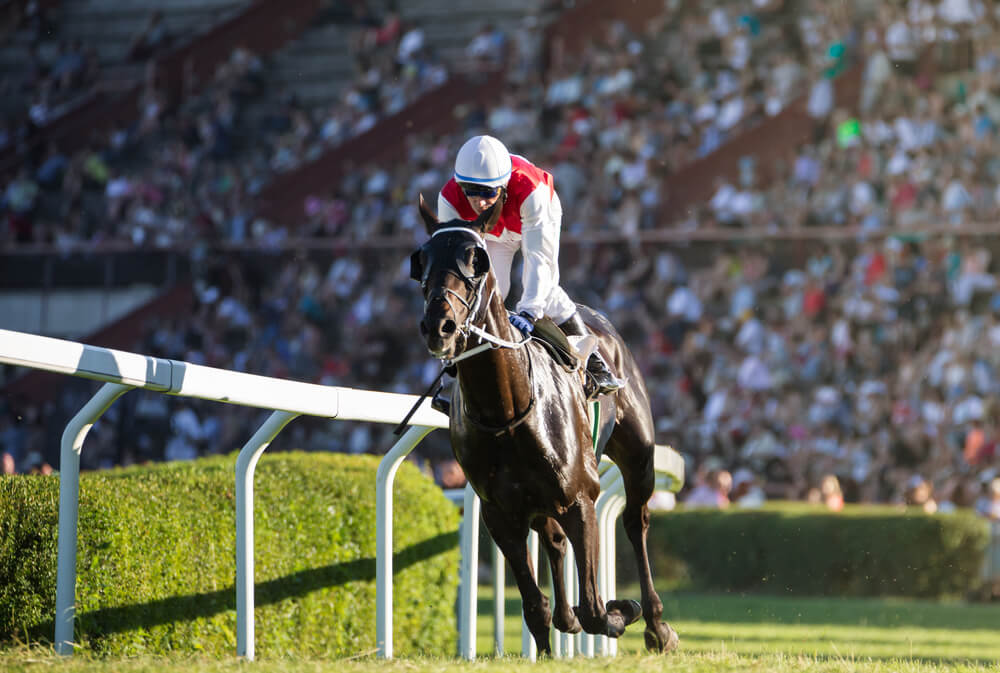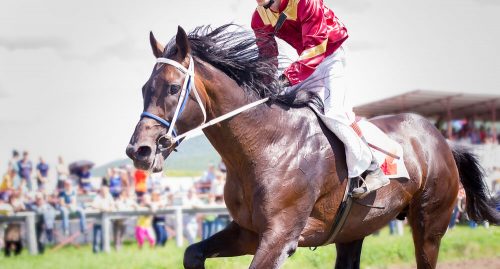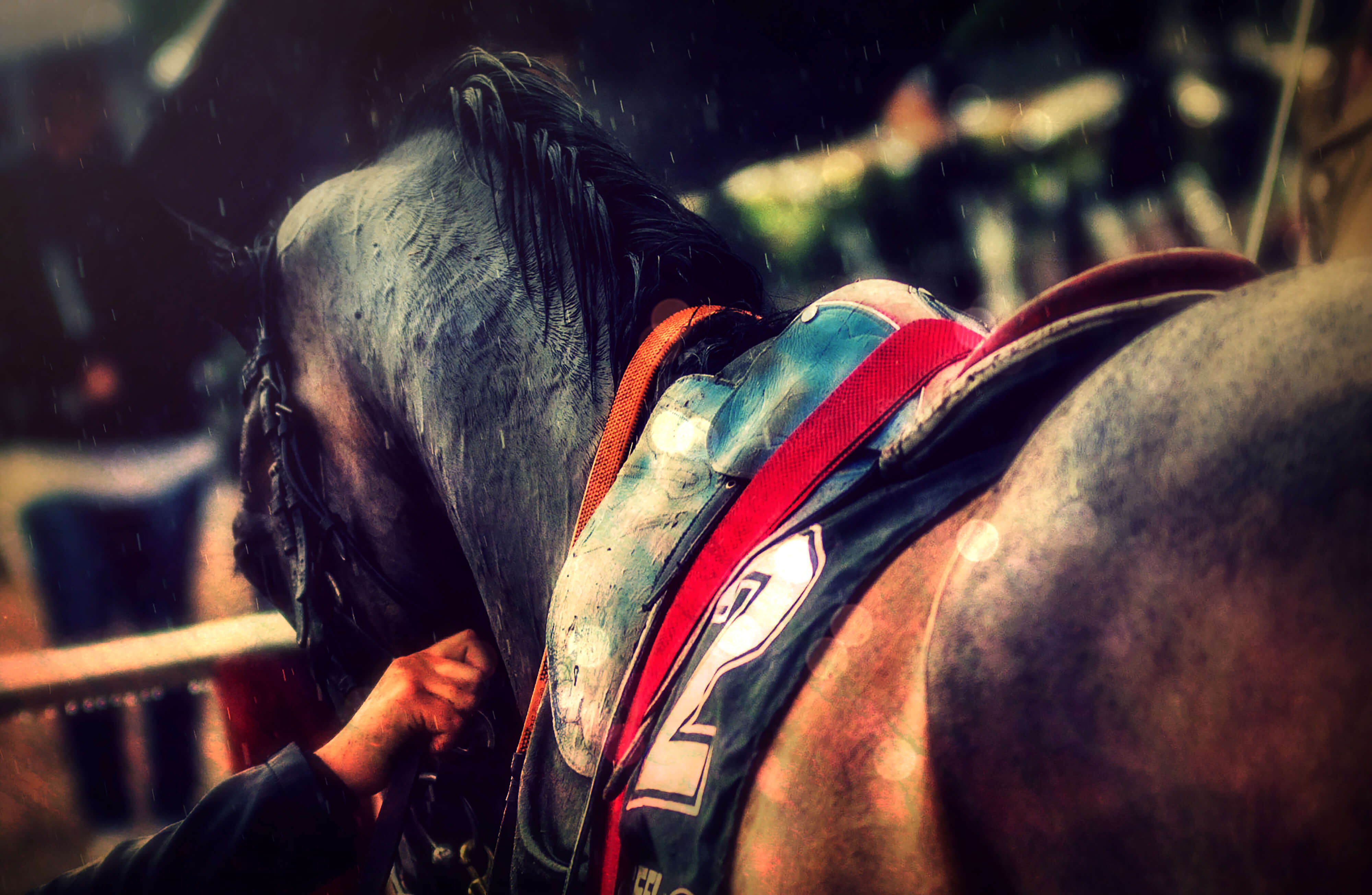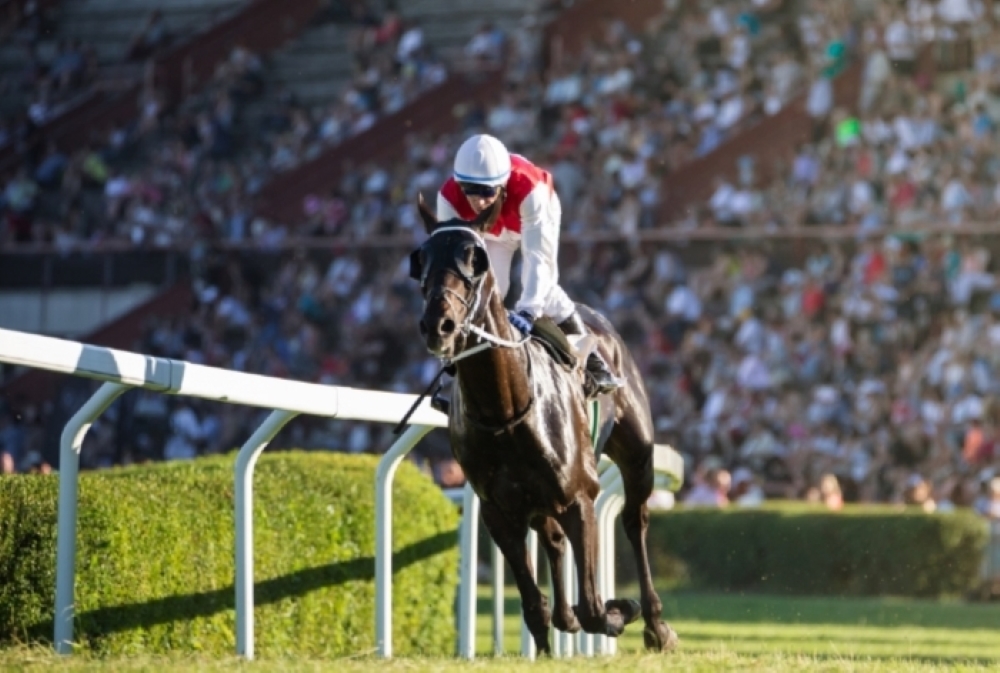T&Cs apply | Wagering and T&Cs apply | Commercial content | New Customers Only | 18+ | Play Responsibly
The Grand National at Aintree has been a British sporting institution since 1839. A horse called Lottery won the inaugural race and Captain Becher fell at a now world famous brook. In those days, horses jumped a stone wall, crossed ploughed land and finished over two hurdles. Read about the legends and key moments that have gone down in Grand National History.
The course was founded by William Lynn, a syndicate head and proprietor of the Waterloo Hotel. He leased land in Aintree from William Molyneux, 2nd Earl of Sefton. Lynn set out a course and built a grandstand. Lord Sefton laid the foundation stone on 7 February 1829. The race was then known as the Grand Liverpool Steeplechase.
Grand National History
Grand National History has made the likes of Red Rum, Aldaniti, Jenny Pitman and Ginger McCain household names. Whilst fences such as Becher’s Brook, The Chair and the Canal Turn are equally familiar.
Given the race’s long history, it is no surprise that many milestones have been reached and remarkable stories have unfolded. For example, no horse has run in the Grand National more times than Manifesto. He competed in eight Grand Nationals between 1895 and 1904, winning in 1897 and 1899. He finished third on three other occasions.
The Aintree Grand National was first run in 1839. Bruce Hobbs, aged 17, was the youngest winning jockey in 1939, on Battleship, the smallest horse ever to win.
Dick Saunders, aged 48, was the oldest successful rider on Grittar in 1982. It was his first and only Grand National ride, after which he retired.
Jenny Pitman was the first woman to train a Grand National winner. She captured the race for the first time with Corbiere in 1983 and again with Royal Athlete in 1995. While in 2009, Venetia Williams became the second woman to saddle a National winner. She won with Mon Mome (11 years after she had actually ridden in the race). More recently both Sue Smith (Auroras Encore 2013) and Lucinda Russell (One For Arthur 2017) have trained Grand National winners.
The winner has been trained by four females over the full Grand National history and here are the details:
- Jenny Pitman 1983 Corbiere 1995 Royal Athlete
- Venetia Williams 2009 Mon Mome
- Sue Smith 2013 Auroras Encore
- Lucinda Russell 2017 One For Arthur
Plenty of the race’s most fascinating stories revolve around its fearsome obstacles. The least number of horses to complete the race is two, in 1928: Tipperary Tim and Billy Barton (who remounted). In 2001, Red Marauder beat Smarty where only four of the forty horses completed, with two having to be remounted.
Many stories in Grand National history concern the unique fences. In 1928 (Tipperary Tim) and 2001 (Red Marauder) there were only two and four finishes respectively.
Early Grand National History
There is actually much debate regarding the first official Grand National. Some leading historians, including John Pinfold, assert that the first running was in 1836 and won by The Duke. This same horse won again in 1837, while Sir William was the winner in 1838. These races have long been disregarded because of the belief that they took place at Maghull and not Aintree.
Some historians have unearthed evidence that suggests those three races were run over the same course at Aintree. Also, that they were regarded as Grand Nationals up until the mid-1860. Contemporary newspaper reports place all the 1836-38 races at Aintree although the 1839 race is the first described as “National”. To date, though, calls for the Nationals of 1836–1838 to be restored to the record books have been unsuccessful.
In 1838 and 1839 three events transformed the Liverpool race from a small local affair to a national event. Firstly, the Great St. Albans Chase was not renewed after 1838. This left a major hole in the chasing calendar. Secondly, the railway arrived in Liverpool, enabling transport to the course by rail. Finally, a committee was formed to better organise the event.
These factors led to a highly publicised race in 1839. It attracted a larger field of top horses and riders, greater press coverage and increased attendance. Over time, the first three runnings were forgotten, securing 1839 its place in Grand National history as the inaugural race.
By the 1840s, Lynn’s ill-health blunted his enthusiasm for Aintree. Edward Topham, a respected handicapper and member of Lynn’s syndicate, began to exert his influence. He turned the chase into a handicap from a weight-for-age race in 1843. He took over the lease in 1848 and one century later, the Topham family bought the course outright.
Grand National History – Leading Characters
Red Rum
It was over 40 years ago that Red Rum recorded the first of three victories in Grand National History. This earned him pride of place in the record books forever. He remains the only horse to have won three Grand Nationals and, was known to be a phenomenon.
Bred to be a sprinter, Red Rum won the gruelling four-and-a-half mile chase in 1973, 1974 and 1977. He finished second on his other two starts, to become the greatest Grand National performer ever. This was achieved after overcoming the bone disease pedalosteitis, which should have rendered him unraceable. However, fate stepped in: Red Rum was at the only yard where the training took place on a beach. Trainer Donald ‘Ginger’ McCain ran Red Rum into the seawater after viewing the hobbling horse, to work an amazing transformation.
On 31 March 1973, he started 9/1 favourite for his first Grand National. However, by the time the runners had reached the Chair, the finish seemed inevitable. The Australian chaser, Crisp, shouldering top weight of 12st (now forbidden), built up a lead with four fences left. But, conceding 23lb to Red Rum, his stamina started to wane and he began to falter at the famous Elbow.
After being more than 15 lengths in front of his rival, Red Rum gradually wore Crisp down. He beat Crisp by three-quarters of a length in a then-record time of 9 min 1.9 sec. It knocked nearly 20 seconds off Golden Miller’s previous best under 12st 2lb in 1934. This new record would stand for the next 16 years.
Foinavon
The 1967 race is one of the most bizarre incidents in Grand National history. The 7th and 23rd fences depending on the circuit is the smallest on the course. Popham Down was riderless and ran across the fence which resulted in a huge pile-up and halted most of the field. Foinavon, ridden by John Buckingham, was able to avoid the other runners and went on alone despite being a 100/1 outsider. The fence is now called Foinavon because the horse went on to win the race.
Buckingham was unaware he was riding the only horse to escape the pile up but kept racing alone. Even though 17 horses remounted or jumped the fence Foinavon had gained such an advantage that the horse cleared the final seven fences well clear of any other horse. The winning distance was 15 lengths and the next horses to complete the race were the favourite Honey End and 1968 winner, Red Alligator. The race is one of the most viewed in Grand National history.
The outsider had finished fourth in the King George and ran in the Cheltenham Gold Cup. The Foinavon fence is just 4ft 6in tall and is positioned between Becher’s Brook and the Canal Turn. The owner of Foinavon was not at Aintree to see his horse win one of the most famous races in Grand National history. The horse fell at the water jump the following year. One of the former owners, the Duchess of Westminster, owned Arkle and Last Suspect who won the Grand National in 1985.
Michael O’Hehir
The commentary of Michael O’Hehir of the carnage at the 23rd fence ranks among the most famous in Grand National history and of BBC televised sport. It is often shown when BBC Sport puts together nostalgic montages of great sports moments. O’Hehir received particular respect from his peers for the speed and unflustered coolness with which he identified Foinavon as the horse emerging from the mêlée. He later said in an interview that it was precisely the unfamiliarity of Foinavon’s colours that made him so instantly recognisable during the race.
O’Hehir visited the weighing room before the race, as is the custom of many National commentators, to familiarise himself more clearly with the colours of the silks but found himself completely stumped when looking at the black with red and yellow braces being worn by John Buckingham. Eventually, O’Hehir had to ask Buckingham who his mount was. A confused O’Hehir said that his racecard showed two-tone green quarters, as worn by the rider in the Cheltenham Gold Cup a few weeks earlier, but Buckingham explained that the owner felt green to be unlucky and so had registered new colours for the National.
The “Iron” Duke of Albuquerque
Over the full Grand National history Beltrán Alfonso Osorio y Díez de Rivera, or the Duke of Albuquerque (1918-1994), is famous for being one of the worst jockeys to ride in the race. He was given a film of the race for his eighth birthday. The boy vowed to win it one day and came close to death in his pursuit of that achievement. He rode in seven Nationals and would more often than not end the day in hospital.
The Iron Duke first rode in the National in 1952, falling from his mount at the sixth fence and broke his neck and suffered a cracked vertebra. He was back in 1963 and fell at the fourth fence this time. Two years later another fall resulted in a broken leg. Bookmakers offered 66/1 for him to complete the course in 1963. The Duke’s stirrup broke during his next National ride in 1973.
In 1974, after having sixteen screws removed from a leg he had broken after falling in another race, he also fell while training for the Grand National and broke his collarbone. Nevertheless, he then competed in a plaster cast, this time actually managing to finish the race for the only time in his splendid career, but only in eighth (and last) place aboard Nereo: “I sat like a sack of potatoes and gave the horse no help” he said after the race thus marking himself in the Grand National history with at least one completed race.
Two quotes after that race summed up the Duke’s efforts in the National. Of his ride on Nereo he said “I sat like a sack of potatoes and gave the horse no help.” In response to his horse barging into Ron Barry’s mount that jockey asked “What the f*** are you doing?” to which the Iron Duke said: “My dear chap I haven’t a clue…I’ve never got this far before!” He is one of the interesting characters in Grand National history.
He rode in the National again in 1976. However, he suffered serious injuries when he was trampled on by a number of horses. The injuries included seven broken ribs, fractured vertebrae, a broken wrist and thigh and severe concussion which left him in a coma for two days. At the age of 57 his jockey’s licence was revoked. He also announced he had ridden in the race for the final time. The Iron Duke did not win the National but suffered more injuries than any other jockey in Grand National history.
Notable Dates in Grand National History
Grand National History 1800s – 1930s
- 1837: THE DUKE finishes first in the Great Liverpool Steeplechase which is run at Maghull, three miles from Aintree.
- 1839: The first Aintree National is won by LOTTERY during which Captain Becher finds himself in the brook.
- 1847: Ireland’s first winner is MATTHEW in a race officially called the Grand National for the first time.
- 1887: GAMECOCK wins the Champion Chase and wins the National the next day at odds of 20/1.
- 1897: MANIFESTO achieves the first of his two wins as the 6/1 favourite. The horse competes eight times up to the age of 16 and finishes third in three other races.
- 1907: EREMON wins the National despite the jockey not riding with stirrups from the second fence.
- 1927: The race is broadcast by the BBC for the first time and the winner is SPRIG ridden by Ted Leader.
- 1928: TIPPERARY TIM wins a National in which only two horses finish after a pile up
reduced the field. It is the lowest number of finishers in Grand National history. - 1934: GOLDEN MILLER wins the Grand National and the Cheltenham Gold Cup in the same season and no other horse has achieved that double.
Grand National history 1940s-1980s
- 1947: It’s misty at Aintree and CAUGHOO beasts 56 rivals but some observers believe the horse only completed one circuit.
- 1956: DEVON LOCH ridden by Dick Francis is well clear in the run-in and certain to win the race for the Queen Mother. Then he sprawls near the line and hands the race to ESB.
- 1967: FOINAVON and John Buckingham’s famous win at 100/1 after the melee at the 23rd fence.
- 1974: NEREO ridden by the Duke of Alburquerque completes the course giving the jockey his one ride over the full distance after several other attempts ended in injury.
- 1977: RED RUM becomes the only horse to win three Nationals after also finishing second twice in five runs from the age of eight to 12.
- 1979: RUBSTIC becomes the first winner trained in Scotland and is welcomed back to his stable by a piper.
- 1981: ALDANITI is ridden by Bob Champion to win the National. The horse recovered from three serious injuries and the jockey beat cancer.
- 1982: Dick Saunders wins on GRITTAR to become the oldest winning rider at 48. Geraldine Rees completes the course on Cheers, the first lady jockey to get round.
- 1983: Aintree is bought by the Jockey Club and Jenny Pitman becomes the first winning female trainer thanks to CORBIERE.
- 1987: Jim Joel becomes the oldest winning owner at 92 when MAORI VENTURE wins a thrilling National.
Grand National history – 1990s
- 1993: The second false start still results in 30 of the 39 jockeys starting the race which is declared void. ESHA NESS trained by Jenny Pitman and ridden by John White passes the post first but the result does not count.
- 1994: MIINNIEHOMA trained by Martin Pipe gives the owner, comedian Freddie Starr, a win in the National. Rosemary Henderson completes the course on her own horse FIDDLERS PIKE as a grandmother at the age of 51.
- 1995: Jenny Pitman trains her second winner with a horse called ROYAL ATHLETE.
- 1997: The race is postponed following two recognised IRA codes for potential bomb threats. The police made the course safe and 60,000 race goers left the track in an orderly manner. There were many vehicles left behind by their owners over the weekend. There were not enough hotel rooms in Liverpool so local residents welcomed many visitors into their homes. One tabloid headline said “We’ll fight them on the Becher’s” in a play on words with reference to Winston Churchill’s wartime speech. The following Monday 20,000 people were given free admission to see LORD GYLLENE win the rearranged Grand National at 14/1.
- 1999: BOBBYJO is Ireland’s first winner for 24 years, trained by Tommy Carberry and ridden by his son Paul.
Grand National history – 2000s
- 2000: Another father and son combination won the race with PAPILLON who was the subject of a massive gamble. It saw the horse backed from 33/1 to 10/1 before winning for the trainer Red Walsh with his son Ruby on board.
- 2001: Four horses finished the race with RED MARAUDER coming out on top in atrocious conditions. There were no major injuries to any horse.
- 2003: MONTY’S PASS wins the race which means the owner, Mike Flutter, nets over £1 million in ante post bets. It helped the horse shorten from 40/1 to a starting price of 16/1.
- 2004: Ginger McCain adds to his three wins with Red Rum as AMBERLEIGH HOUSE wins the National after finishing third a year earlier.
- 2005: HEDGEHUNTER ridden by Ruby Walsh becomes the first winner since Corbiere in 1983 to carry more than 11 stone. The main sponsor’s are now John Smith’s after taking over from Martell.
- 2006: The new sponsors introduce the John Smith’s People’s race. It gives members of the public a chance to ride in a Flat race on Grand National day at Aintree. The event took place until 2010 but was then halted.
- 2008: COMPLY OR DIE wins the race for trainer David Pipe who emulates his father in training a Grand National winner.
- 2009: MON MOME is returned at 100/1 and becomes the biggest priced winner in Grand National history since Foinavon in 1967. Venetia Williams is the second female in Grand National history to train the winning horse.
Recent Grand National history
- 2010: Tony McCoy finally wins his first race in Grand National history on DON’T PUSH IT, trained by Jonjo O’Neill and owned by JP McManus, after 15 rides. The win helps McCoy win the BBC Sport Personality of the Year Award.
- 2011: BALLABRIGGS prevails trained by Donald McCain who wins the race for the first tim. He joins his father Ginger on the Grand National history roll of honour as the trainer of Red Rum and Amberleigh House.
- 2012: NEPTUNE COLLONGES edges out Sunnyhillboy in a close finish to give Paul Nicholls his first win in the race. Seabass finishes third so Katie Walsh achieves the best result for a female jockey on a horse trained by her father, Ted.
- 2013: AURORAS ENCORE wins the race at 66/1 for trainer Sue Smith who is married to the former show jumper, Harvey. There were only two fallers on the first circuit. Evan Williams trains a placed horse for the fifth time in five years.
- 2014: The Grand National is worth £1 million for the first time and the winner is PINEAU DE RE trained by Dr Richard Newland who is not a full time trainer. Williams has another placed horse in the form of Alvarado.
- 2015: MANY CLOUDS wins the race against Grand National history trends as an eight-year-old carrying 11st 9lbs. The horse is owned by Trevor Hemmings and it is his third win in the National.
- 2016: RULE THE WORLD wins the National ridden by inexperienced jockey David Mullins and become a rare novice winner in Grand National history.
- 2017: ONE FOR ARTHUR joins Rubstic as the only winners trained in Scotland in Grand National history. Lucinda Russell is only the fourth female trainer to win the race.
- 2018: TIGER ROLL who won the cross country race at the Cheltenham Festival gives jockey Davy Russell his first win in the race.
In April 2021 another horse will become part of Grand National history. The race is one of the most famous in the world. Each renewal adds a chapter to the long and varied Grand National history. The race is unique for a number of reasons and for many years to come winners will add to the Grand National history.






